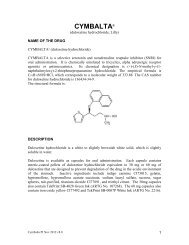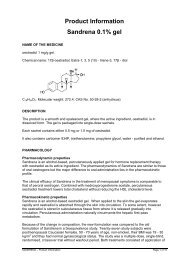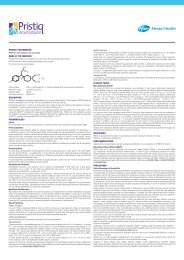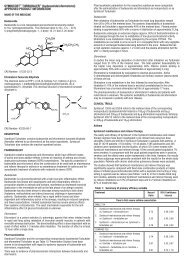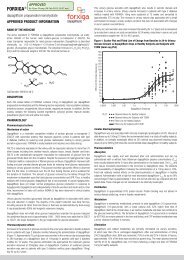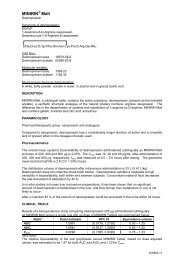MINIRIN® Nasal Spray - DriveTime Radio Home Page
MINIRIN® Nasal Spray - DriveTime Radio Home Page
MINIRIN® Nasal Spray - DriveTime Radio Home Page
Create successful ePaper yourself
Turn your PDF publications into a flip-book with our unique Google optimized e-Paper software.
PRODUCT INFORMATION<br />
MINIRIN ® <strong>Nasal</strong> <strong>Spray</strong><br />
NAME OF THE MEDICINE:<br />
Desmopressin Acetate<br />
Synonyms:<br />
DDAVP<br />
1-desamino-8-D-Arginine vasopressin.<br />
Desamino-cys-1-D-Arginine-8 vasopressin.<br />
CAS No. 62357-86-2 (trihydrate)<br />
DESCRIPTION:<br />
The active substance is a synthetic structural analogue of the natural hormone arginine vasopressin. Early treatment of central<br />
diabetes insipidus used a more or less purified extract from bovine or porcine posterior pituitaries. These caused unpleasant<br />
complications of use. When vasopressin became known, two forms were found - Arginine Vasopressin (found in humans) and<br />
lysine vasopressin (found in pig pituitaries).<br />
Two chemical changes have been made to the natural hormone:<br />
a. desamination of the N-terminal of cysteine-1<br />
b. substitution of 8-D-arginine for 8-L-arginine<br />
SCH2CH2CO-Tyr-Phe-Gln-Asn-Cys-Pro-D-Arg-Gly-NH2<br />
Minirin <strong>Nasal</strong> <strong>Spray</strong> contains desmopressin acetate, sodium chloride, citric acid monohydrate, sodium phosphate-dibasic<br />
dihydrate, benzalkonium chloride solution 50% as preservative and purified water.<br />
PHARMACOLOGY:<br />
According to results from antidiuretic and pressor tests in rats these changes increase antidiuretic activity three to five fold while<br />
pressor activity is reduced to 0.1% of that of antidiuretic hormone.<br />
Pharmacokinetics<br />
a. Absorption: Using i.v. or i.m. doses, 100% is available. Used intranasally, it is estimated that 10% is available. Thus i.v. or<br />
i.m. doses are one tenth that of the intranasal route. The extent of absorption is similar for the spray and the rhinyle with a trend<br />
towards higher absorption associated with the spray. Mean Cmax and AUC values are approximately 40% higher with the spray<br />
than with the rhinyle; however, there is considerable intra and inter individual variability in plasma levels of desmopressin.<br />
b. Distribution: It is believed to be similar to ADH. No information is available on protein binding.<br />
c. Metabolism: It is thought that the presence of the D-isomer in position eight protects desmopressin acetate from the enzyme<br />
which inactivates ADH.<br />
d. Excretion: The excretion of desmopressin acetate is similar to that of ADH but considerably slower. Clinically intranasal<br />
desmopressin acetate is effective for approximately 10-12 hours.<br />
Half-Life No information is available for intranasal administration. For i.v. administration of labelled desmopressin acetate,<br />
biexponential half lives of 7.8 minutes and 75.5 minutes were recorded. The duration of drug effect is 8-20 hours, with much<br />
individual variation.<br />
CLINICAL IMPLICATIONS OF PHARMACOKINETIC DATA:<br />
Desmopressin acetate is thought to be resistant to the inactivation that occurs with ADH. Intravenous or intramuscular doses<br />
should be about one tenth the intranasal dose for equivalent efficacy.<br />
In some patients, the duration of effect may be sufficiently long to permit once daily dosage if the single dose can be tolerated.<br />
ACTIONS:<br />
The actions of Minirin can be summarised as follows:<br />
Antidiuretic Action<br />
Minirin acts at a receptor site in the renal collecting tubule to increase permeability to water reabsorption.<br />
Effect on factor-VIII<br />
High doses of desmopressin acetate produce marked and sustained increases of factor-VIII coagulant activity (VIII:C) as well as<br />
of the von Willebrand factor (vWF). At the same time plasminogen activator is released.<br />
Effect on Bleeding Time<br />
At doses of 0.3-0.4µg/kg desmopressin acetate results in a normalisation of, or marked reduction in the prolonged skin (template)<br />
bleeding time. The exact mechanism of this effect is not known.<br />
It is not known whether the effects of Minirin are direct or act through a mediator or second messenger.<br />
There is a temporal correlation between a reduction in bleeding time and the presence in plasma of high molecular weight<br />
monomers of the von Willebrand factor which are thought to be released from storage sites. It is thought likely that Minirin exerts<br />
its effect through its V2-receptor agonist activity.<br />
OTHER EFFECTS:<br />
Oxytocic Effect A slight in vitro oxytocic effect has been reported in animals. A slight stimulatory effect on uterine activity in<br />
non-pregnant women has been noted at doses of 15 and 20 micrograms intranasally. See use in pregnancy.<br />
#152-v13A
PRODUCT INFORMATION<br />
INDICATIONS:<br />
Diabetes Insipidus<br />
The treatment of ADH-sensitive cranial diabetes insipidus, including treatment of post-hypophysectomy polydipsia and polyuria.<br />
Desmopressin acetate is ineffective for the treatment of nephrogenic diabetes insipidus. Administration of desmopressin acetate<br />
by intravenous or intramuscular injection may be used when the intranasal route is inconvenient. Caution: The intravenous or<br />
intramuscular dose is about one tenth of the intranasal dose. Note: Minirin <strong>Nasal</strong> <strong>Spray</strong> is for intranasal administration only.<br />
Nocturnal Enuresis<br />
Minirin <strong>Nasal</strong> <strong>Spray</strong> is indicated for the symptomatic treatment of primary nocturnal enuresis in patients who have normal ability to<br />
concentrate urine. Minirin <strong>Nasal</strong> <strong>Spray</strong> should be used only in patients who are refractory to the enuresis alarm or in patients in<br />
whom enuresis alarm is contraindicated or inappropriate.<br />
Renal Concentrating Capacity<br />
By intranasal administration to adults and children as a diagnostic test to establish renal concentrating capacity.<br />
CONTRAINDICATIONS:<br />
Habitual and psychogenic polydipsia.<br />
Cardiac insufficiency and other conditions requiring treatment with diuretic agents.<br />
Hypersensitivity to desmopressin acetate or any of the components of Minirin <strong>Nasal</strong> <strong>Spray</strong>.<br />
SIADH; syndrome of inappropriate anti-diuretic hormone secretion.<br />
Known Hyponatraemia.<br />
Moderate and severe renal insufficiency (creatinine clearance below 50mL/min).<br />
PRECAUTIONS:<br />
a. Only use nasal spray in patients where orally administered formulations are not feasible (See – Post Marketing Experience).<br />
b. Overhydration: The risk of overhydration including cardiac failure should be borne in mind, especially in children or the<br />
elderly or in chronic use and when desmopressin acetate is being used to test renal concentrating capacity or the patient is on<br />
fluid supplements either orally or parenterally. Children should be closely observed to avoid overingestion of fluid (see Precautions<br />
– Hyponatraemia and Precautions – Fluid Intake) and to ensure that only the recommended dose of Minirin is taken<br />
c. Laboratory Tests: For the healthy patient with primary nocturnal enuresis, it is advisable to check serum electrolytes at least<br />
once if therapy is continued beyond seven days.<br />
d. Hyponatraemia: Treatment without concomitant reduction of fluid intake may lead to water retention/hyponatraemia with<br />
accompanying signs and symptoms (headache, nausea/vomiting, decreased serum sodium, weight gain, and, in serious cases,<br />
convulsions). The risk of hyponatraemia seems to be greater during the first weeks following initiation of therapy.<br />
e. Fluid Intake: When used for diagnostic purposes the fluid intake must be limited and not exceed 0.5 L from 1 hour before until<br />
8 hours after administration.<br />
When used for the treatment of nocturnal enuresis the fluid intake must be limited to a minimum and only to satisfy thirst from one<br />
hour before until eight hours after administration.<br />
f. In the control of diabetes insipidus the lowest effective dose should be used. Patient dosage should be reassessed<br />
periodically.<br />
g. Desmopressin acetate should not be administered to dehydrated or overhydrated patients until water balance has been<br />
adequately restored.<br />
h. <strong>Nasal</strong> infections/rhinorrhoea. Intranasal administration may be ineffective and unreliable absorption may result in the<br />
presence of local infection or rhinorrhoea. Treatment should cease until condition resolves in patients being treated for enuresis.<br />
Bodyweight should be regularly monitored.<br />
i. Myocardial ischaemia. Desmopressin acetate should be used with caution in patients with cardiovascular disease and the<br />
elderly.<br />
j. Hypersensitivity. Patients with a known hypersensitivity to ADH, should be tested for sensitivity to desmopressin acetate<br />
before the full dose is given.<br />
k. Post-operative use. For polyuria and polydipsia developing in the immediate post-operative period, desmopressin should<br />
only be given in minute doses, as extreme sensitivity to it may be present and over-hydration can be very damaging at that time.<br />
The maintenance of fluid intake in the light of serial weights, fluid losses, serum electrolytes and serum and urine osmolalities,<br />
rather than giving desmopressin may often be a safer course in the early post-operative course of such cases in childhood.<br />
l. Minirin <strong>Nasal</strong> <strong>Spray</strong> should be used with caution in patients with cystic fibrosis because of impaired water handling and<br />
increased risk of hyponatraemia.<br />
m. Precautions to prevent fluid overload must be taken in patients at risk of increased intracranial pressure.<br />
n. Renal concentrating capacity testing in children below the age of 1 year should only be performed under carefully supervised<br />
conditions in hospital.<br />
o. Severe bladder dysfunction and outlet obstruction should be considered before starting treatment for primary nocturnal<br />
enuresis.<br />
p. Treatment with desmopressin should be reassessed during acute intercurrent illness and the fluid and electrolyte balance<br />
should be carefully monitored.<br />
q. Additional information. High doses of desmopressin such as those used to treat bleeding are contraindicated in patients with<br />
Type IIB von Willebrand's disease. Use of Minirin <strong>Nasal</strong> <strong>Spray</strong> in this patient group is not approved or recommended. At high<br />
doses, intravenously administered desmopressin has a vasodilatory effect and may cause a minor decrease in systolic or diastolic<br />
blood pressure. In haemophilia where high doses are given extreme care is paid to water balance.<br />
r. Ensure adult supervision when a child is administering the drug.<br />
s. Increase dose progressively and with caution.<br />
#152-v13A
PRODUCT INFORMATION<br />
USE IN PREGNANCY:<br />
Category B2. Reproduction studies performed in rats and rabbits with subcutaneous doses up to 50ng/kg/day and 10µg/kg/day,<br />
respectively, have revealed no evidence of harm to the foetus due to desmopressin. There are several publications on the<br />
management of diabetes insipidus in pregnant women with no harm to the foetus reported, however, no controlled studies in<br />
pregnant women have been carried out. Published reports stress that, as opposed to preparations containing the natural<br />
hormone, MINIRIN in anti-diuretic doses has no uterotonic action, but the physician will have to weigh possible therapeutic<br />
advantages against possible dangers in each individual case.<br />
USE IN LACTATION:<br />
Subtherapeutic levels of desmopressin acetate have been detected in the breast milk of lactating women. Until further evidence<br />
of its safe use during lactation is available, it is not to be administered to lactating women.<br />
CARCINOGENICITY/MUTAGENICITY:<br />
See Use In Pregnancy.<br />
INTERACTIONS WITH OTHER MEDICINES:<br />
• NSAIDs may induce fluid retention/hyponatraemia.<br />
• Substances which are known to release antidiuretic hormone, e.g. tricyclic antidepressants, chlorpromazine and<br />
carbamazepine, may cause an additive antidiuretic effect and increase the risk of water retention.<br />
• Use of large doses of intranasal desmopressin with other pressor agents should only be done with careful patient monitoring.<br />
ADVERSE EFFECTS:<br />
Infrequently, high dosages of Minirin <strong>Nasal</strong> <strong>Spray</strong> or Minirin Intranasal Solution have produced transient headache and nausea.<br />
<strong>Nasal</strong> congestion, rhinitis and flushing have also been reported occasionally along with mild abdominal cramps. These symptoms<br />
disappeared with reduction in dosage. Nosebleed, sore throat, cough and upper respiratory infections have also been reported.<br />
The following table lists the percent of patients having adverse experiences without regard to relationship to study drug from the<br />
pooled pivotal study data for nocturnal enuresis.<br />
Adverse Reaction<br />
Body as a Whole<br />
Abdominal Pain<br />
Asthenia<br />
Chills<br />
Headache<br />
Throat Pain<br />
Nervous System<br />
Depression<br />
Dizziness<br />
Respiratory System<br />
Epistaxis<br />
Nostril Pain<br />
Respiratory Infection<br />
Rhinitis<br />
Placebo<br />
(N=59)<br />
Desmopressin<br />
20mcg (N=60)<br />
Desmopressin<br />
40mcg (N=61)<br />
% % %<br />
0<br />
0<br />
0<br />
0<br />
2<br />
2<br />
0<br />
2<br />
0<br />
2<br />
2<br />
Cardiovascular System<br />
Vasodilation 2 0 0<br />
Digestive System<br />
Gastrointestinal Disorder<br />
Nausea<br />
0<br />
0<br />
2<br />
0<br />
0<br />
2<br />
0<br />
0<br />
0<br />
3<br />
2<br />
0<br />
8<br />
2<br />
0<br />
2<br />
2<br />
2<br />
5<br />
0<br />
0<br />
3<br />
0<br />
0<br />
0<br />
3<br />
0<br />
2<br />
#152-v13A
PRODUCT INFORMATION<br />
Adverse Reaction<br />
Skin & Appendages<br />
Leg Rash<br />
Rash<br />
Special Senses<br />
Conjunctivitis<br />
Edema Eyes<br />
Lachrymation Disorder<br />
Placebo<br />
(N=59)<br />
2<br />
2<br />
0<br />
0<br />
0<br />
Desmopressin<br />
20mcg (N=60)<br />
0<br />
0<br />
2<br />
2<br />
0<br />
Desmopressin<br />
40mcg (N=61)<br />
Post marketing experience<br />
A worldwide survey of adverse reactions following the spray in patients with nocturnal enuresis reported the infrequent occurrence<br />
of hyponatraemia, water intoxication oedema, convulsions, syncope and unconsciousness.<br />
Hyponatraemia is an infrequent but serious adverse event, which has been reported at a rate of approximately 15 cases per<br />
100,000 patient years of exposure for intranasal formulations and 6 cases per 100,000 years for oral formulations.<br />
Isolated cases of allergic skin reactions and more severe general allergic reactions have been reported. Isolated cases of<br />
emotional disturbances in children have been reported.<br />
DOSAGE AND ADMINISTRATION:<br />
a. For ADH-sensitive Cranial Diabetes Insipidus<br />
Adult. The average daily dose is 10 to 40 micrograms intranasally. The daily dose is usually given as two divided doses.<br />
The dosage must be determined for each individual patient and adjusted according to the diurnal pattern of response.<br />
Response should be estimated by two parameters: adequate duration of sleep and adequate, not excessive, water turnover.<br />
In the event of signs of water retention/hyponatraemia, treatment should be interrupted and the dose adjusted. A single<br />
daily dose may be appropriate if it is tolerated and also satisfactorily controls the diabetes insipidus. About one third of<br />
patients may be controlled on a small daily dose. For immediate postoperative polyuria and polydipsia, the dose should be<br />
controlled by measurement of the urine osmolality.<br />
Paediatric<br />
Intranasal. 2.5 to 20 micrograms daily.<br />
b. Nocturnal Enuresis<br />
Dosage should be adjusted according to the individual. The recommended initial dose for those 6 years of age and older is<br />
20 micrograms (µg) or 0.2 mL solution intranasally at bed time. Adjustment up to 40 µg is suggested if the patient does not<br />
respond. Some patients may respond to 10 and a downward adjustment to 10 µg can be made if the patient responds to 20<br />
µg. Note that each actuation of the spray contains 10 µg of desmopressin acetate. It is recommended that one half of the<br />
dose be administered per nostril. Since the spray cannot deliver less than 10 µg, smaller doses should be delivered by the<br />
rhinyle delivery system. A restricted fluid intake is recommended overnight after administration. (See Precautions: Fluid<br />
Intake). Patients should be treated for an initial period of 1-3 months followed by a withdrawal of 1 week to assess cure rate.<br />
Relapsed patients should be continued for a further 1-3 months at the standard dose.<br />
c. As a diagnostic test of renal concentrating capacity (See Precautions: Overhydration and Fluid Intake)<br />
Intranasal<br />
Adults: Single dose of up to 40 micrograms<br />
Children: Single dose of up to 20 micrograms<br />
Infants: Single dose of up to 10 micrograms (See Precautions)<br />
INSTRUCTIONS TO BE GIVEN TO PATIENTS:<br />
<strong>Spray</strong><br />
The physician should carefully explain the use of the spray device and advise the patient not to inhale. Patients should be<br />
instructed to read accompanying directions on use of the spray pump carefully before use. Prime the spray before using it for the<br />
first time by pressing it at least four times, or until an even spray is obtained. If the spray has not been used during the last 7 days<br />
it is necessary to prime it again by pressing it a couple of times until an even spray is obtained before placing the nozzle in the<br />
nostril.<br />
OVERDOSAGE:<br />
LD50 for animals has not been established but no untoward reactions were observed in mice which received 2 milligrams/kg by<br />
intravenous injection. Overdosage of Minirin can lead to water retention and hyponatraemia. Treatment is based on restoration<br />
of fluid and electrolyte balance. Although the treatment of hyponatraemia should be individualised, the following general<br />
recommendations can be given. Asymptomatic hyponatraemia is treated by discontinuing the desmopressin treatment and fluid<br />
restriction. Infusion of isotonic or hypertonic sodium chloride may be added in cases with symptoms. When the water retention is<br />
severe (convulsions and unconsciousness) treatment with frusemide should be added.<br />
0<br />
0<br />
0<br />
0<br />
2<br />
#152-v13A
PRODUCT INFORMATION<br />
PRESENTATION AND STORAGE CONDITIONS:<br />
<strong>Spray</strong> pump of 5 mL delivering 50 doses of 10 µg desmopressin acetate (Not marketed in Australia).<br />
<strong>Spray</strong> pump of 6 mL delivering 60 doses of 10 µg desmopressin acetate.<br />
Desmopressin free base represents 89% of the desmopressin acetate content. This is due to the difference in molecular weight<br />
as well as the presence of acetic acid/acetate, water and impurities.<br />
Store below 25°C. Protect from light. Do not freeze.<br />
NAME AND ADDRESS OF THE SPONSOR:<br />
Ferring Pharmaceuticals Pty Ltd, Suite 2B, Level 2, 802 Pacific Highway, Gordon, NSW, 2072, AUSTRALIA<br />
POISON SCHEDULE OF THE MEDICINE:<br />
Prescription Medicines<br />
[Therapeutic Goods Administration Approved: 11 April 1997].<br />
[Date of most recent notification 28 November 2008]<br />
#152-v13A



